Originally hailing from 4th-century Persia, Spinacia Oleracea or spinach has a long and storied past as a health tonic, a poor man’s food, a favorite of big-forearmed sailor men, and a choice food of health gurus.
We are constantly hearing about how important it is to eat your leafy greens, and for good reason—they’re fantastic for you and delicious! But with the number of pesticides used on conventional greens, and with the high price of organic greens, the best choice, in this writer’s mind, is to grow your own.
Planting Spinach
To plant, soak spinach seeds in water or compost tea for a few hours before sowing them directly into the ground. If planting in rows, the seeds should be planted about 1/2-inch deep, 2 inches apart.
Spinach beds should be in full or semi-full sunlight for best results, though if you live in a warm region with hot weather, you may want to plant taller plants beside your spinach beds to offer some shade during the heat of the day.
When should you plant spinach?
Spinach requires plenty of cool weather from seeding to harvest, so it’s best to plant the seeds six weeks before the last frost date. It is recommended that you sow spinach seeds directly into the ground as soon as the soil temperature is no less than 45 degrees Fahrenheit.
You can replant spinach seedlings around August if you prefer to have a fall crop. Just make sure the ground temperature is no warmer than 70 degrees Fahrenheit.
MARTIN MALEC / FLICKR (CREATIVE COMMONS)
Can spinach be transplanted?
Although spinach seeds can be started indoors, it is not recommended. The reasoning for this is that spinach seedlings have delicate root systems that don’t like to be disturbed, and transplanting them may trigger it to bolt prematurely.
This plant seems to detest being transplanted. Besides, it grows so well in cold, frosty ground that starting seeds indoors probably offers little advantage.
However, if you are hell-bent on starting them indoors; it’s important that you harden off young plants before transplanting. Be careful to not disturb the roots, just plant the entire cup or section directly into the ground. Add plenty of nitrogen-heavy fertilizer to promote growth.
Related Post: Foraging for Wild Spinach
Should you fertilize spinach?
Before planting, prepare your spinach beds by planting a cover crop over the winter or adding some compost or organic matter—spinach does well with rich, neutral soil. Once they are planted, you should fertilize them every 2 to 3 weeks.
Spinach also needs lots of nitrogen, so a 15-10-10 fertilizer would be the best choice for this hungry plant. Use a water-soluble fertilizer in order to feed your spinach plants without disrupting their shallow roots.
Growing Conditions
Though they can be grown by gardeners in any USDA growing zone, spinach is primarily a cool-weather crop. It’s possible for spinach to survive in full sun or partial shade, however, they do best when receiving 4-6 hours of sunlight a day.
Spinach will grow quickly in well-drained soil with a pH between 6.5 and 7.5. Make sure they receive at least 1 to 1 ½ inches of water per week.
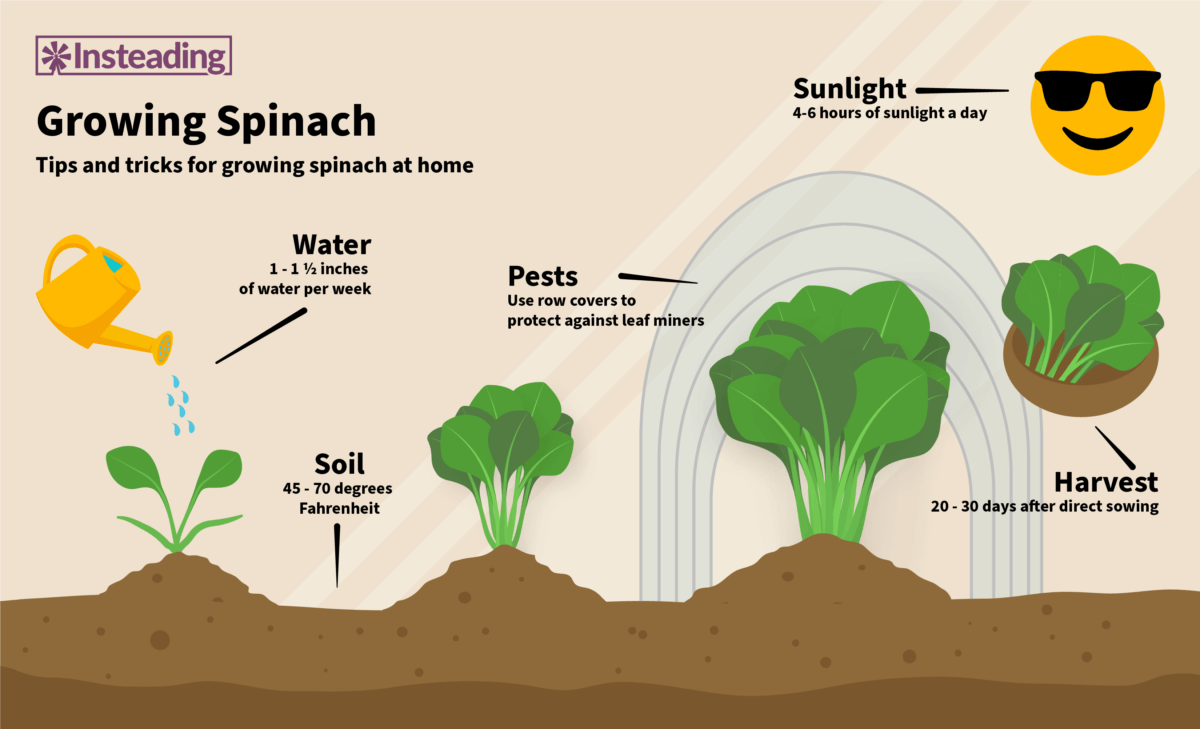
What companion plants are compatible with spinach?
Spinach is compatible with a variety of plants, as long as their growing requirements are similar. Companion plants for spinach include cabbage, kale, cauliflower, eggplants, lettuce, brussel sprouts, strawberries, garlic, radish, beans, peas, marigolds.
However, avoid planting them near fennel and potatoes as they are incompatible.
Related Post: Growing Cabbage
ENGLISH SPINACH SEEDLING. DOUG BECKERS / FLICKR (CREATIVE COMMONS)
What’s the best temperature for spinach?
Spinach will do best when the soil temperature is between 45 to 70 degrees Fahrenheit. Therefore, late spring and early fall are excellent seasons to grow this crop.
As an early spring green, it just doesn’t want to be around during the hot summer. You wouldn’t expect to see ephemeral spring wildflowers like spring beauties or trout lilies in mid-July…neither should you expect to have acres of tender spinach.
The plants can also survive light frosts, so they are a fantastic component of a winter garden—especially if you live in a region where winters don’t get much cooler than 25 degrees Fahrenheit.
Why does spinach bolt prematurely?
If left to its own devices, spinach will bolt as soon as it feels a little heat, putting all of its energy into making seeds and cutting off the growth of those tender, tasty greens.
Bolting spinach is merely responding to long days and temperature. Like any plant, it wants to make seeds as efficiently as possible so that it can propagate itself. So, the longer the day and the higher the temperature that surrounds a mature plant, the more likely it is to try to flower.
Therefore, one of the biggest considerations you should take when planting spinach is the timing. If you plant spinach too late in the season, it may feel too much heat and bolt prematurely.
Tips For A Bountiful Harvest
Spinach is a fast-growing plant and can yield plentiful harvests during their growing season. Follow these tips to get the most out of your spinach plant.
How can I encourage more spinach leaves to grow?
It’s important to thin out your spinach plants once they reach 2 inches in height. This method may seem counterintuitive, however, it encourages new growth and better quality leaves.
Simply choose seedlings that don’t look as healthy as others, and snip them off at the base. Thinning them out, your spinach plants should have about 4 to 6 inches of space between them. This allows enough space for them to grow new, true leaves.
Spinach-succession strategy
Now, if you’re super-serious about getting a haul of spinach, I offer you this spinach-succession strategy inspired by The Complete Vegetable & Herb Gardener.
In earliest spring, about six weeks before the last frost, plant a row of cold-tolerant cultivars of spinach (try “Norfolk”). Continue planting a row or so of seeds every two weeks, shifting over to more heat-tolerant varieties like “sohshu,” “king of Denmark” or “Bloomsdale long standing.”
MARCO VERCH / FLICKR (CREATIVE COMMONS)
Once the spring has warmed to over 70 degrees, sow spinach alternatives, like Swiss chard or Malabar spinach to hold you over until the weather cools.
Once its time to switch gears and do your fall plantings (usually in late summer), plant the varieties that are more susceptible to cold weather, like “winter Bloomsdale,” “Virginia savoy,” or “Norfolk.”
Related Post: Tips For Surviving Winter’s Worst
Keep those rows well-mulched or grow in a cold frame, and that will help you extend the late fall harvest. That should give you the maximum amount of greens with a little less disappointment!
Harvesting Spinach
The more you work with your plants, the more you’ll develop an innate sense of when it’s time for leaves to be plucked. Here are some general guidelines for when and how to harvest your spinach.
When is spinach ready to be harvested?
It’s easy to know when it’s time to harvest spinach—simply pick it when the leaves are big enough to use! On average, spinach leaves are ready to be harvested within 20 to 30 days after direct sowing.
Whether you’re looking for baby greens for their mild flavor and soft texture, or mature leaves better suited for cooking: deciding when to harvest your spinach leaves is really up to personal preference.
How to harvest spinach leaves
Use a pair of scissors and snip the stem of each leaf you want to harvest. Don’t harvest more than ⅓ of each plant, and new leaves will be ready to be harvested again in a few days.
Plan to harvest spinach in the early morning when it’s cool, if possible. Otherwise, bring a bowl of cool water out with you while collecting—plunge the leaves in as soon as you cut them to keep them fresh and unwilted.
How to harvest the entire spinach plant
The early spring varieties—those prone to bolt—are often harvested by grabbing the entire plant and snipping the leaves from the base with clean scissors or a knife.
Leave 2 inches of stem sticking up from the ground—including the tender growing point in the center— to give yourself the chance to make a second and third harvest.
Related Post: Growing Lettuce
When should you pull spinach plants?
Your spinach plants are likely to bolt towards the end of spring due to warmer temperatures. Therefore, it’s a good idea to pull the entire plant around this time.
Alternatively, you can leave a few plants to purposely bolt and go to seed—this will give you the seeds you need for the next planting season’s round of spinach! Be aware that all true spinach varieties can cross—and they’re wind-pollinated. One way to make sure your plants breed true is to plant only one cultivar.
Common Spinach Plant Diseases And Pests
If you only see a few of the tell-tale paths on your spinach, simply discard the affected leaves. In the case of a more serious infestation, Jere Gettle, founder of the Baker Creek Heirloom Seed Company, recommends using row covers.
Blight and downy mildew
The most common diseases with spinach are blight and downy mildew. Both of these are caused when spinach matures in warm weather, so the best way to avoid them is to plant your spinach as early as possible!
In addition, be sure to water your spinach early in the day to give ample time to dry before night. Using drip irrigation is another way to avoid this.
Leaf Miners
On the pest front, you’ll probably wage war with leaf miners more than any other insect. You’ll know when this pest is around if you see yellow spots on your spinach leaves. Since these are a leaf crop, I strongly discourage using any sort of chemical pesticide to resolve the problem: You’d be spraying poison directly on your food!
Using a row cover is a preferable way to deter these pests, along with rotating your spinach crop. You should be keeping your garden clean by weeding regularly, as weeds can also play host to spinach leafminers.
Choosing Between Spinach Varieties
There are many spinach varieties to choose from! I love looking through the Annie’s Heirloom and Baker Creek catalogs and dreaming leafy dreams. Spinach comes in all shapes and sizes, and choosing one is no easy task.
What does “savoy-leaved” mean?
As you choose your spinach plants, you may notice that some varieties are described as savoy-leaved. To those unfamiliar with the term, “savoy” is a term used to describe wrinkled, crinkled leaves.
Savoy style leaves hold up much better when cooked, but all those nooks and crannies are notorious for hiding pockets of dirt. An ancient anecdote about preparing savoy-leafed spinach is to wash it 12 times before cooking—11 times in water and the final rinse in frustrated human tears!
The alternative to savoy-leaved spinach is smooth spinach—you’ve seen this type when you buy a bag of baby spinach at the grocery store.
Heirloom Varieties
To be honest, I only recommend heirloom varieties—I love growing wonderfully unique varieties not available in stores, preserving open-pollinated heirloom plants, and saving seeds for next year’s garden.
Hybrid varieties don’t breed true, so keep that in mind when saving your seeds!
Heat-Loving Spinach Alternatives
So, you love spinach as much as I do (that’s a lot), but maybe you’re finding that it always bolts or doesn’t grow well in your area.
Or, maybe you just didn’t get the seeds in the ground in time, and now it’s too warm to grow it. Don’t give up hope! If your garden never seems to produce spinach, here’s a veritable army of lesser-known yet just-as-delicious spinach alternatives to fill in your need for greens.
Strawberry Spinach
You may want to grow this bizarre, easy-to-grow plant for its Willy Wonka looks alone! Both the leaves and mildly-sweet berries are edible. This cousin of quinoa is reported to be relatively pest-free as well!
Wild Spinach
You can buy seeds for Chenopodium album here, but it may just be easier to take a walk in your backyard—it’s probably growing wild there already. Also a relative of quinoa, it is so easy to grow, thriving in poor soils and dry areas.
WREN EVERETT / INSTEADING
Though the stems do get woody late in the summer, the leaves are tender and sweet all season long.
Related Post: Wild Spinach
Wherever I live, I find, transplant, and cultivate a patch of these super-versatile wild greens.
Red Aztec Spinach
Yes, yet another quinoa relative, and probably the most drought-resistant of the lot. Red Aztec Spinach thrives in dry conditions and even offers an edible grain at the end of the season.
Red Malabar Spinach
Though this heat-loving vine is not related to spinach, its greens can be used in exactly the same salads and stir-fries. Tropical gardens can grow it as a perennial, but more temperate areas will have to grow it as an annual.
New Zealand Spinach
If you live in an area with dramatic weather changes, this may be the green for you! Though New Zealand Spinach can’t handle a frost, it can steadily produce greens through the hottest summer you can throw at it.
MBALAZS2 / FLICKR (CREATIVE COMMONS)
As this summer winds down, and all your hard-working summer beds start getting worn out, don’t throw in the towel just yet! Slap your gloves back on, dress up a row with some beautiful compost, and get those spinach seeds in the ground.
As the trees start to display the first touches of orange and gold, your garden can still be lush with the deep, rich green of this useful and nutritious plant.
Resources
- The American Horticultural Society Illustrated Encyclopedia of Gardening: Vegetables
- The Complete Vegetable & Herb Gardener, Karan Davis Cutler
- The Heirloom Life Gardener, Jere and Emilee Gettle


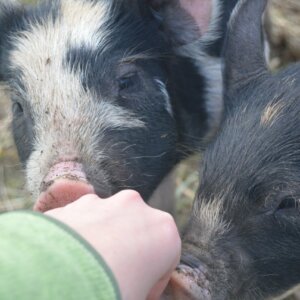

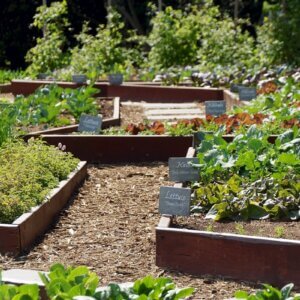


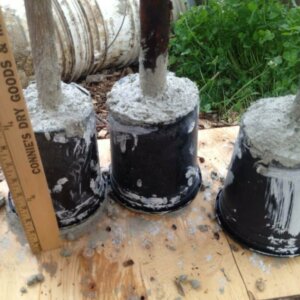
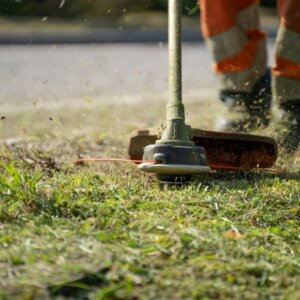





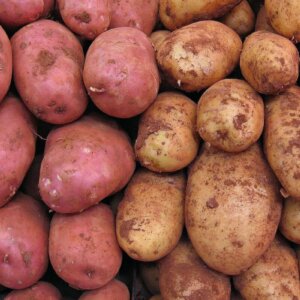

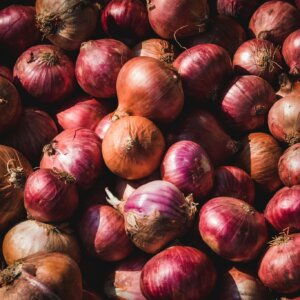

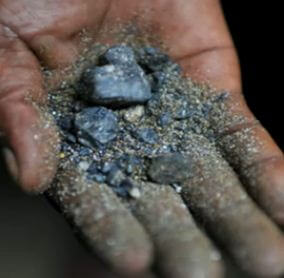
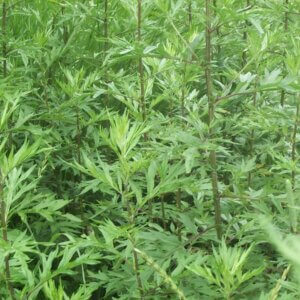



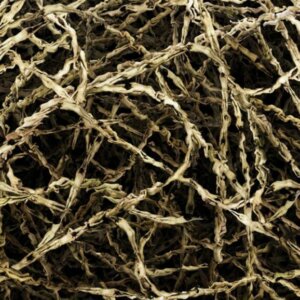


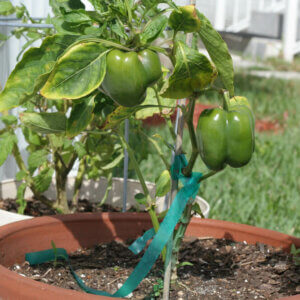
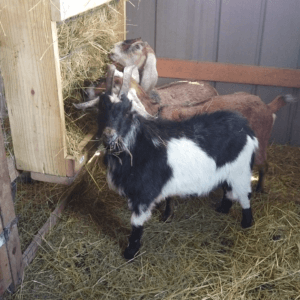
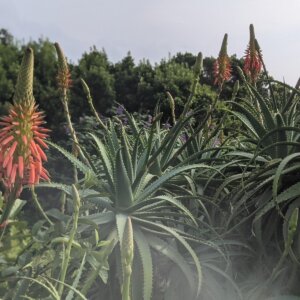

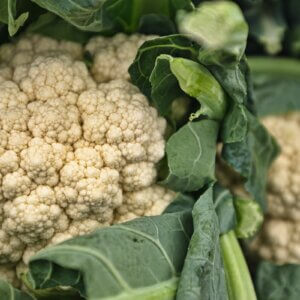


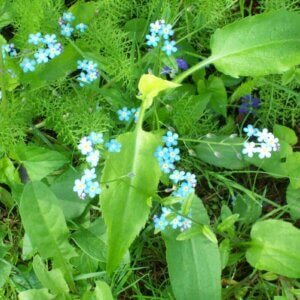




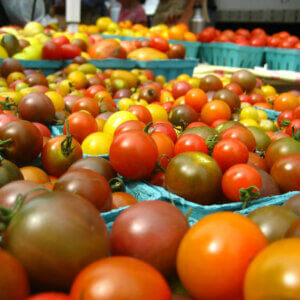
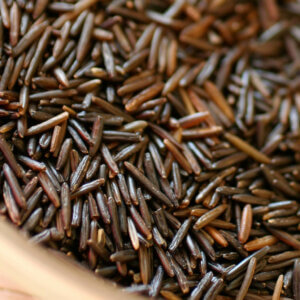
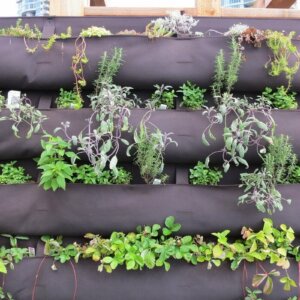

thank you for creating this article